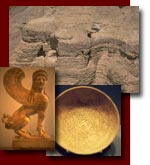| Site Map | Contacts | Links | Newsletter | |
Biblical Archaeology:
Mt. Sinai
There are various suggestions as to were Mt. Sinai is. De Vaux believes that the theophany of Sinai was a description of a volcanic eruption in northern Arabia (1978, 432-8). Exodus 19:18 describes the mountain like a furnace of smoke. From a distance it would look like a pillar of cloud in the day, and a pillar of fire at night. Following this cloud of smoke would lead them right to the volcano. There are no volcanoes in Sinai, but there are several in northern Arabia (Lee 1996, 20). The only known large eruption around this time is Santorini on the Greek island of Thera (Simkin et al. 1981, 111). Professor Goedicke thinks a giant tidal-like wave called a tsunami caused by the eruption of Santorini, destroyed the Egyptian army, and the eruption formed the pillar of cloud and fire in Exodus (Shanks 1981, 42-50; Oren 1981, 46-53). Note that at the time of Ogyges there occurred the first great deluge in Greece. Ogyges "lived at the same time of the Exodus from Egypt" (Eusebius 1981, 524). Maybe a tsunami caused this deluge in Greece?
Jewish tradition seems to place Mt. Sinai in Arabia. Demetrius stated that Dedan was Jethro's ancestor which is identified with the oasis of el-'Ela, and when Moses went to Midian he stayed in Arabia (De Vaux 1978, 435). In Josephus' book Antiquities of the Jews he placed Sinai where the city of Madiane was (Antiquities, II.264; III.76). In the Babylonian Talmud (Sotah 5a) R. Huna and R. Hisda say, "the Holy One, blessed be He, ignored all the mountains and heights and caused His Shechinah to abide upon Mount Sinai" (Freedman and Simon 1935, 18-19).
According to Old Testament passages Mt. Sinai is identified with Seir and Mt. Paran. Deuteronomy 33:2 says, "The Lord came from Sinai, and rose up from Seir unto them; he shined forth from mount Paran" (KJV, see also Judges 5:4-5, Hab. 3:3,7; Axelsson, 1987; Simons 1959). It seems that the itinerary that was followed in Numbers 33:18-36 locates Sinai in northern Arabia. Midian was also located here (I Kings 11:18) where Moses lived with Jethro, priest of Midian, for forty years (Exodus 2:15, 3:1).
According to the New Testament, Paul in Galatians 4:25 states, "For this (H)Agar is mount Sinai in Arabia" (KJV). Paul is probably following Jewish tradition that placed mount Sinai in northern Arabia.
From Egyptian topographical lists one area the Shasu lived in was Seir. One place is called "land of the Shasu Yhw" (Axelsson 1987, 60). Yhw is used as a toponym, a place-name, which is most likely named after a deity. Yhw corresponds to the Old Testament YHWH, which would make this the earliest known reference. Axelsson concludes, "Thus it is conceivable that the full name of the area in question was Yhw's land, Yhw's city, Yhw's mountain, or the like" (Axelsson 1987, 60). After further study Astour places this city north of Israel in Lebanon (1979, 17-34; for more on the origins of YHWH see, De Moor, 1990, Huffmon, 1971, Murtonen, 1951).
Tradition seems to place Mt. Sinai in Arabia (see article by Allen Kerkeslager "Mt. Sinai-in Arabia?" in Bible Review April, 2000 pages 32-39, 52). The Septuagint translators thought Jethro was from a city named Madian (Madiam). This ancient city was located in northwestern Arabia not far from Jabal al Lawz, the tallest mountain in the area at 8,500 feet. "Qurayyah ware, a pottery style usually associated with the Midainites, indicates that the large oasis at Al-Bad' was probably a Midianite settlement in the Late Bronze and early Ion Ages (Ibid, 36). Other evidence comes from Demetrius the Chronographer (cited in Eusebius Preaparatio Evangelica 9:29.1-3). Philo placed Mt. Sinai in northwestern Arabia and says that Moses "went up the highest and most sacred of the mountains in its region" (Ibid, 37; Moses 2.70). The Book of Jubilees 8:19 seems to locate Mt. Sinai in the Arabian peninsula. Origen, Eusebius and Jerome all locate Mt. Sinai in Arabia (Ibid, 39) For more details see the article by Allen Kerkeslager "Mt. Sinai-in Arabia."
